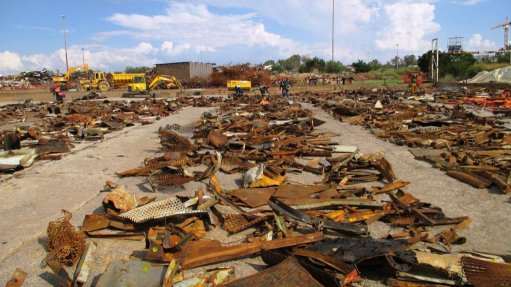
ION-OPENING EXPERIENCING Radiological decontamination and demolition projects can involve a range of procedures, including radiological scanning and testing of scrap metal after ultra-high pressure washing
The development of new infrastructure, particularly in the expanding local mining sector, has created opportunities for demolition solutions provider Jet Demolition to be involved in sectional demolition and decontamination projects, particularly those involving radiological decontamination.
Although the company has undertaken more than 60 projects that have had some form of radiological decontamination since 1994, Jet Demolition contracts manager Kate Bester mentions that these projects are not as common as conventional demolition, as only a small sector of the local industry has processes with radioactivity as a consequence.
She explains that, generally, large-scale radiological decontamination and demolition projects can take from six months to two years, depending on the scope and whether sectional demolition is required.
With such demolition projects, Bester emphasises the importance of safety, adding that a strict and clear reporting protocol is undertaken to ensure full cradle-to-grave accountability of materials.
She also highlights the difficulty of incorporating subcontractors into radiological contamination projects.
“Regulations call for extremely specific and controlled deployment, training and monitoring of personnel on site. Owing to this, we typically undertake the majority of decontamination works in-house, ensuring the safety of all involved.”
Bester adds that the South African Hazardous Substances Act, as amended by the Nuclear Energy Act, governs radiation contamination activities and provides the framework for all monitoring and reporting for radiation workers. The Act sets a safe occupational dose limit for radiation workers at 100 millisieverts per five-year period, averaged yearly.
Moreover, she points out that Jet Demolition complies to the safety measures set by the National Nuclear Regulator (NNR). The NNR ensures that local companies comply with local safety laws, as well as the regulations set by the International Atomic Energy Agency Safety Standards.
Bester highlights an example of a project where measures were implemented to adhere to this safety regulation and reduce exposure of workers to radiation.
Apart from two large concrete ore silos that were blasted with low levels of human activity, mechanical demolition by excavators up to 102 t in mass was used for all other plant and equipment during this project.
This reduced the amount of human interaction with the radiated areas, and subsequently the exposure of workers to radiation.
“Our preference will always be to use our dedicated fleet of demolition excavators for large-scale projects. International best practice is heavily focused on separating people from risk, and our fleet of machines give us the resources we need to do so effectively.”
“Owing to their height and geometry, the two large ore silos were well suited to using explosives. They had a large footprint into which they could be toppled safely. At the time of blasting, all personnel, except for the blaster and his assistants, evacuated the area.”
In addition, other procedures, including an extensive radiation training programme and the use of specialised personal protective equipment (PPE), were implemented to minimise exposure to radiation.
The PPE ranged from standard hard hats, safety boots and dust masks to disposable overalls for working with asbestos, dedicated respirators with specialised filters, and Kevlar suits to protect ultrahigh-water-pressure operators.
Further, there is also the requirement to deal with radiological waste, particularly in the safe handling and storage of materials.
Local legislation provides clear guidance for safe handling processes, in addition to the disposal and recycling of contaminated materials.
Bester adds that the company further ensures that activities are monitored and guided by a registered radiation protection officer, who performs all testing and classification of materials leaving the site.
“By ensuring that the strictest protocols are fully complied with in terms of cradle-to-grave reporting, the process is streamlined, effective and as efficient as possible.”
Bester emphasises that the company is fully capable of completing such projects on a turnkey basis.